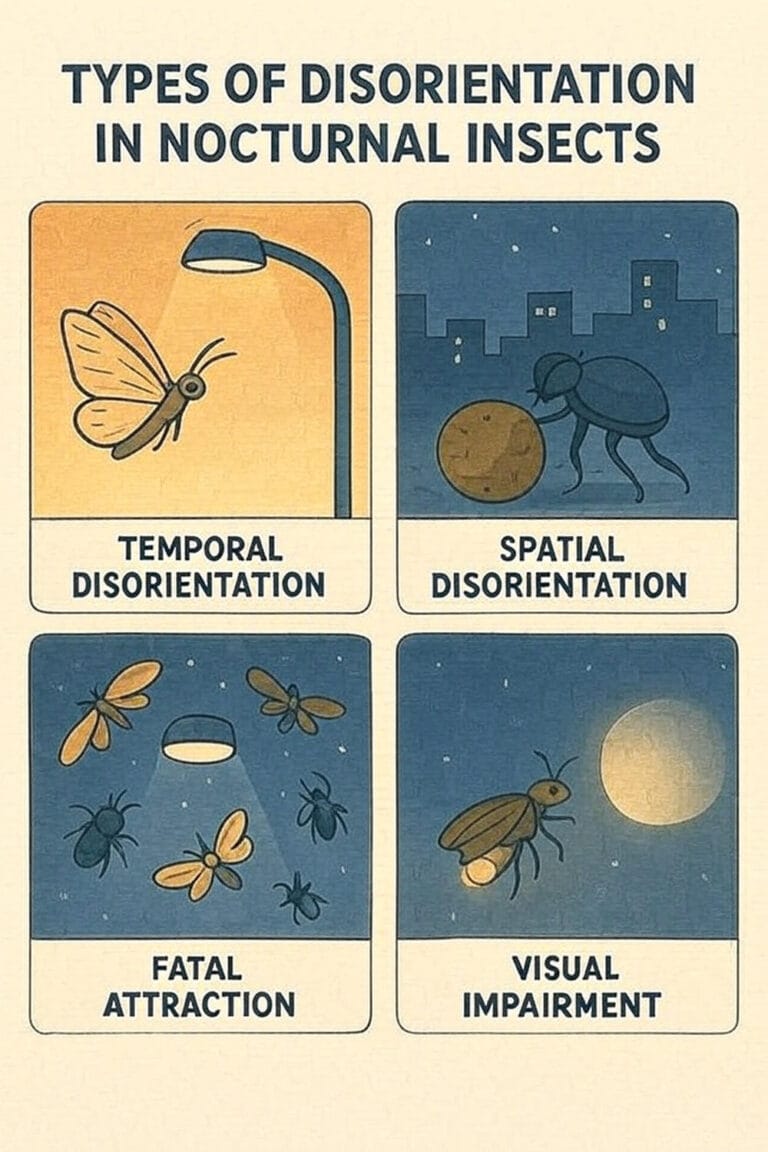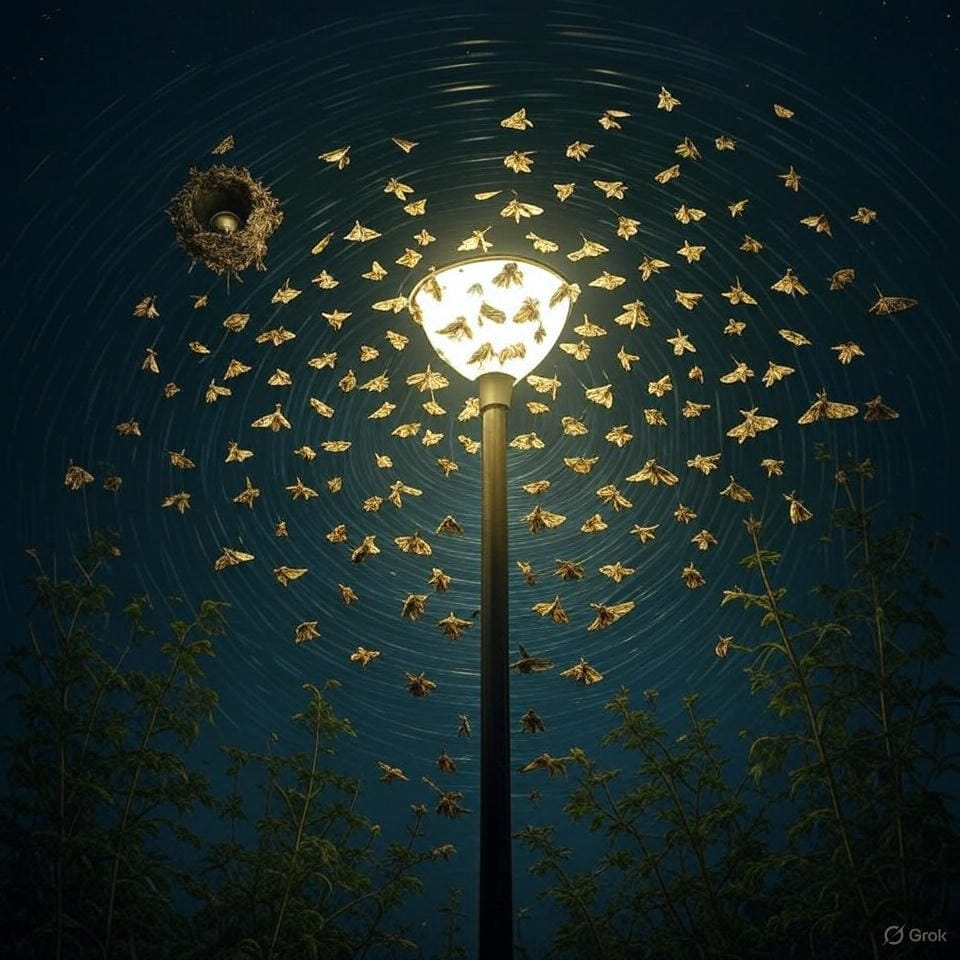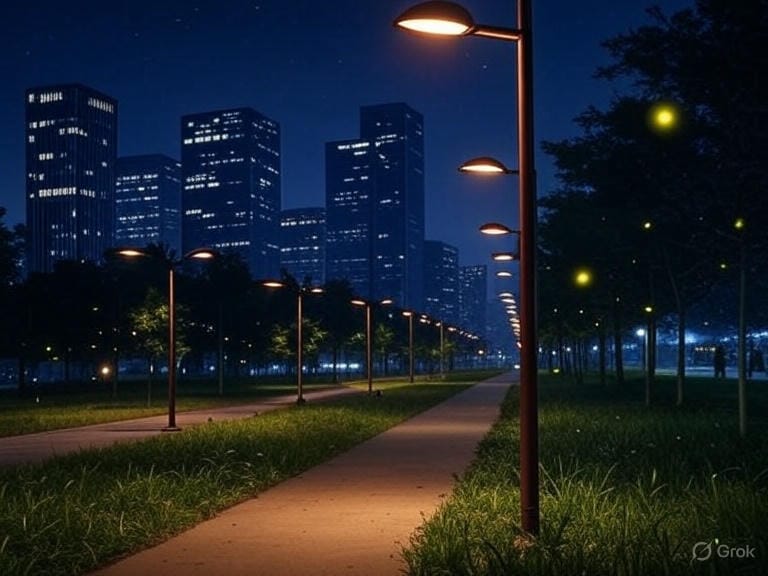
Table of Contents
ToggleHow Light Pollution Harms Nocturnal Insects
Imagine a quiet night in your backyard where a moth flutters towards a bright porch light. It circles around the light endlessly and becomes too confused to fly away. They revolve until exhaustion or a predator ends their life. This isn’t just one insect’s story- it’s happening with billions of insects worldwide every night due to the effect of light pollution on nocturnal animals.
Artificial Light at Night (ALAN) from streetlamps, billboards and city glow turns dark skies into deadly traps for nocturnal insects like moths, beetles and fireflies. Light pollution comes in the form of direct glare from bulbs or skyglow that brightens the entire horizon. These nocturnal insects become active after sunset and rely on natural darkness for survival. They use moonlight and stars to navigate, find food or mate.
But ALAN affects all these activities by drawing them towards itself like a magnet and causing massive die-offs. This picture is scary: Insects have declined by about 40% globally since 2000 and all this happened because of a hidden threat. This isn’t just bad for bugs, it’s a crisis for us too. Nocturnal insects pollinate plants at night which supports crops worth over $500 billion yearly.
Their loss disturbs food chains and hurts birds, bats & even fish that eat them. In the end it threatens entire ecosystems and our food supply. In this article we’ll dive into why insects are so vulnerable, the effects of light pollution on nocturnal animals and real ways to fix it.

Core impact of light pollution on nocturnal animals
Nighttime artificial light creates big problems for those insects that come out after dark. It messes with their daily lives and often leads to early deaths. Here are some major hidden impacts of light pollution on nocturnal animals:-
Temporal Disorientation
Artificial lights disrupt the timing when insects eat, mate or rest. Take an example of moths, some of them start flying around too early or too late because the glow tricks their body clocks into thinking it’s not fully night. This mismatch means they might not find food when it’s available. This weakens them over time and cuts down on baby insects being born.
Spatial Disorientation and Navigation Failures
Many organisms use the moon or stars as a compass to navigate around. But bright City Light blocks these signals and compels them to circle around the wrong areas. Take dung beetles as an example- they normally roll their food in straight paths using sky hints but lights scatter them and break their homes & making it harder to survive long trips.
Fatal Attraction and Ecological Traps
Insects get pulled toward lights uncontrollably. A pull that’s stronger with brighter or blue-tinted bulbs. They buzz around the source of light until they’re too tired to fly or easy prey for bats and spiders nearby. In busy roads or cities this can wipe out huge numbers and turn a place that should be a safe spot into a deadly setup where these insects waste energy without escaping.
Desensitization and Visual Impairment
Too much light can overload their sensitive eyes or it can make them blind for a while. This makes spotting mates, dodging enemies or grabbing a meal tough. Overall it leaves them vulnerable and less active.
Recognition and Behavioral Disruptions
The glare of Light pollution hides important signals like how fireflies flash to find partners or how moths spot each other. It also ruins their hiding tricks that make them visible to hunters and moms might lay eggs in bad places because they can’t see right.n
There is a new type of impact –Synergistic Threats. Lights don’t act alone, instead they team up with warmer weather from climate shifts or Bug-killing chemicals from farms. It speeds up population decline by adding extra stress on already struggling organisms.

The Ripple effects of light pollution on nocturnal animals
The effect of light pollution on nocturnal animals doesn’t stop at the insects, it spreads like ripples in a pond that mess with plant growth, animal food chains and whole natural areas. According to the U.S. Geological Survey (USGS), insects are declining at alarming rates worldwide, threatening pollination, food webs, and ecosystems.
Pollination Disruption
Lots of flowers depend on night bugs like moths to spread their pollen when we are sleeping. But lights full these helpers away and it slashes pollinators’ visits to plants in glowing spots. Crops such as chocolate trees or certain fruits suffer which lower harvests that could hurt farmers’ incomes and make food prices higher for everyone. Without enough pollination some plants might even die.
Food Web Cascades
Bugs(insects) are the starting point for many animal diets. When light kills them off, birds, bats and frogs have less to eat, which leads to their population decline. For example, fewer moths mean hungrier chicks in nests which weakens bird groups. This imbalance slows down how nature recycles nutrients because some bugs break down dead stuff which affects soil health and plant regrowth everywhere.
Biodiversity Hotspots at Risk
Some places are packed with life, like rainforests or city parks. And these places get hit the worst. In urban zones, constant lights split up bug homes and wipe out unique types of them that can’t adapt. Tropical edges face extra pressure from growing towns- it mixes light issues with tree cutting and pushes rare species closer to vanishing. Even water areas suffer if bugs that start life in streams get confused by nearby glows.

The Science of Nocturnal Insect Vision and ALAN Vulnerability
Nocturnal insects have evolved amazing eyes to thrive in the dark but artificial light at night (ALAN) throws everything off. Think of their vision like super super-sensitive camera design for low light. Many insects such as moths and beetles use compound eyes with a special structure called superposition optics. This setup stacks the flight from multiple lenses onto one spot and lets them see clearly even under faint moonlight or stars. Their eyes are effective in detecting ultraviolet, blue and green wavelengths which helps them to find food, mates or safe spots.
But do you know where ALAN causes trouble? Bright human lights, especially those rich in blue tones like LEDs act like a false signal. Insects consider the horizonr moothe n and get pulled towards them uncontrollably. It’s a behavior called positive phototaxis. This isn’t about attraction to warmth or safety; it’s a navigation glitch. For example – flying insects tilt their backs toward the brightest point, thinking that it’s “up”. Eventually it sends them spiraling in a loop until they’re exhausted or trapped.
Key weaknesses include disrupted daily rhythms where constant glow confuses sleep-wake cycles and reduces their feeding or breeding time. Pulsing lights can trigger erratic darts which increase crash risks. Fireflies also suffer, as ALAN drowns out their glowing signals for mating. Overall this vulnerability leads to higher death rates from starvation, predators or direct hits. Understanding the science of light pollution on nocturnal animals can make it easier for you to differentiate.
Mitigation and solutions of light pollution
Reducing the effect of Light pollution on nocturnal animals can be done by smarter lighting. A simple step is using “insect-friendly” bulbs. Amber or red LEDs are better than white ones because they give off less blue light which attracts fewer bugs. To save insects and energy both we have to add covers to point light only downward and use motion sensors to turn lights on only when they’re needed.
On a larger level, our cities can set up dark sky zones where lights dim after midnight. In parks or green areas lower brightness and focus beams only on paths can reduce insect deaths. Some countries like those in the EU already have rules for eco-friendly lighting and similar laws can help everywhere.
At home, you can help by turning off outdoor lights, planting trees to block extra light and reporting poorly bright spots through apps. New research shows that switching lights on end of an interval can free insects from light traps. For farms we can use blended red lights that protect pollinators and still give workers enough light to work.
FAQs
How does light pollution affect nocturnal animals?
Light pollution disrupts the natural behavior of nocturnal animals. It confuses their internal clocks, affects migration patterns and also makes it harder for them to hunt, mate or hide from predators. Many species such as bats, moths and sea turtles lose their natural navigation cues due to artificial lighting.
Why light pollution is harmful for insects
Most nocturnal insects like moths are drawn to artificial lights which act as fatal traps. This reduces their populations which directly affects pollination and food chains. Other animals that depend on insects for food such as birds and bats also suffer from this decline.
How to reduce impact of light pollution on nocturnal animals
Some simple steps include using amber or red-tinted LED bulbs that direct lights downward with shields. Install motion sensors and turn off unnecessary outdoor lighting. On a bigger scale cities can create dark sky zones and pass eco-friendly lighting laws to protect nocturnal animals.
